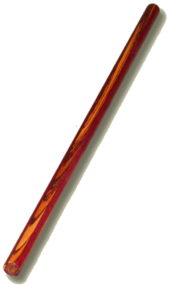Hanbō
The Hanbō [ hamboː ] ( Japanese半 棒) is one of the striking and thrusting weapons with a length of 80 to 100 cm (thickness depending on hand size approx. 2.3 to 3 cm). The name means "half of a Bō " ( Han "half", Bō "stick").
description
In Japan the hanbō is known as the koryū weapon. There is trained in Kukishin Ryu (approx. 14th century) and Hontai Yōshin-ryū . The Kukishin Ryu, which is still practiced in the schools of jujutsu , which go back to Takamatsu Toshitsugu ( Bujinkan , Jinenkan and Genbukan) , is particularly well known . The Hanbō was included in the curriculum of Kukishin Ryu by Nagafusa Kuriyama in 1575 after his spear was smashed by the opposing swordsman in a fight and he continued to fight with the rest of the shaft and thus defeated it. A weapon very similar to the Hanbō is the Tanjo ; This is a western-style walking stick that was used by Uchida Ryogoro to develop self-defense techniques in the early 1900s. The style is named after its developer Uchida Ryu Tanjo Jutsu and is now taught in Shinto Muso Ryu. Due to its small size it is quite easy to hide and can be used effectively in combat by twisting the wrist in quick attacks. However, only about 20% of uses with this weapon consist of knocks and blows. The Hanbō is used much more for levering . The hanbō is available in several styles. In Kobudō , Ninjutsu , Jujutsu , Karate (different styles) and also in Aikidō . There the forms ( Kata ) were taught and partly changed. In Germany in particular, the Hanbō was established as a further weapon by Georg Stiebler , as this weapon is a good addition to karate and jujutsu training.
The advantages of the Hanbō can be found in close combat, where you can use not only effective lever but also push and punch techniques. Accordingly, outside of close combat, ranged weapons like the Bō are usually superior to the Hanbō, as they have a greater range.
Hanbō-kata
Kata of Hanbojutsu
Kukishin Ryu These kata are kata with a partner.
- Kamae-gata:
- 1. Otonashi
- 2. Shinsen
- 3. Kachimi
- 4. Danpi
- 5. Outai
- Kihon-gata or Furi-kata
- Omotenokata
- 1. Tachiotoshi
- 2. Atekomi
- 3. Koshiore
- 4. Ategaeshi
- 5. Tsukiiri
- Chugokui
- 1. Kirinohitoha
- 2. Otoshimatsuba
- 3. Mizudori
- 4. Gorinkudaki
.5. Mawaridori
- Gokuino kata
- 1. Tsurunohitokoe
- 2. Karamedori
- 3. Shin-no-karamedori
- Sensudori
- 1. Tenno-kata
- 2. Chino-kata
- 3. Jinno-kata
Kata in Ryukyu Kobujutsu Hozon Shinkokai
- Sanjakubo
This kata is only trained in Ryukyu Kobujutsu Hozon Shinkokai, in the other Kobudo styles / associations based on Taira Shinken it is not trained.
Katas of the Gendai-Goshin-Kobu-Jutsu:
- Renshuho Shodan
- Renshuho Nidan
- Renshuho Sandan
- Renshuho Yondan
- Renshuho Godan
- Renshuho Kaiten
- Fudoshin no Sho
- Fudoshin no Dai
- Hate no sho
- Hate no dai
- Tsuken no Sho
- Kanjo
See also
The following weapons are among the stick weapons in Japanese and Okinawan systems:
literature
- Werner Lind : The dictionary of martial arts . Sportverlag, Berlin 1999, ISBN 3-328-00838-1
- Georg Stiebler: Bo-Karate, Hanbo Jitsu - the techniques of stick fighting . Falken Verlag, ISBN 3-8068-0447-8
- Steven Utracik: Hanbo Jutsu . lulu.com, 2011, ISBN 978-1446727782
Web links
Individual evidence
- ↑ Shoto Tanemura: Hanbo-Jutsu, Self-Defense With Staff & Stick. Saitama (Japan) 2006
- ↑ http://www.kampaibudokai.org/Tanjo.htm
- ^ Organization for Preserving Kuki Shinden (2007), archive link ( Memento from July 22, 2011 in the Internet Archive )
